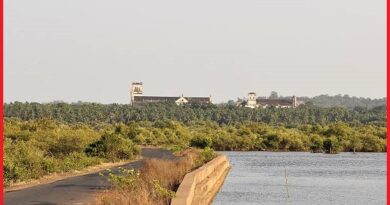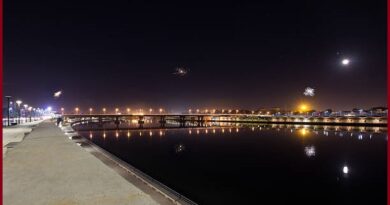Agra Fort-A Magnificent Mughal Stronghold of Architectural Splendor
Agra fort
Agra Fort, also known as the Red Fort of Agra, is a historic fort located in the city of Agra, Uttar Pradesh, India. The important 16th-century Mughal monument stands near the gardens of the Taj Mahal. This powerful fortress of red sandstone encompasses, within its 2.5-km-long enclosure walls, the imperial city of the Mughal rulers. It comprises many fairy-tale palaces, such as the Jahangir Palace and the Khas Mahal, built by Shah Jahan; audience halls, such as the Diwan-i-Khas; and two very beautiful mosques.
The Fort is situated on the banks of the Yamuna River in the city of Agra. It is a complex showcases a fusion of Mughal and Islamic architectural styles. It features imposing red sandstone walls that stretch for approximately 2.5 kilometers, encircling the inner palaces and other structures. The fort’s design includes intricate carvings, exquisite marble inlays, and beautiful gardens.
Within the fort, there are several notable structures, including the Diwan-i-Am, Diwan-i-Khas, Khas Mahal, Sheesh Mahal, Musamman Burj, and Jahangiri Mahal. These palaces and structures exhibit intricate architecture, beautiful decorations, and splendid views. The Fort is a major tourist attraction, drawing visitors from around the world who are fascinated by its grandeur and historical significance.
Agra fort History
Agra Fort was the main residence of the emperors of the Mughal Dynasty till 1638, when the capital was shifted from Agra to Delhi. The fort is a UNESCO World Heritage site. It is about 2.5 km from more famous sister monument, the Taj Mahal.
After the First Battle of Panipat in 1526, the victorious Babur stayed in the fort. He later built a baoli in it. His successor, Humayun, was crowned in the fort in 1530. He was defeated at Bilgram in 1540 by Sher Shah Suri. The fort remained with the Suris till 1555, when Humayun recaptured it.

Realising the importance of its central situation, Akbar made it his capital and arrived in Agra in 1558. His historian, Abul Fazl, recorded that this was a brick fort known as ‘Badalgarh’. It was in a ruined condition and Akbar had it rebuilt with red sandstone from Barauli area Dhaulpur district, in Rajasthan. Architects laid the foundation and it was built with bricks in the inner core with sandstone on external surfaces. Some 4,000 builders worked on it daily for eight years, completing it in 1573.
It was only during the reign of Akbar’s grandson, Shah Jahan, that the site took on its current state. Shah Jahan built the beautiful Taj Mahal in the memory of his wife, Mumtaz Mahal.
Also read- Jantar Mantar- A extraordinary Place and UNESCO World Heritage site
Sheesh mahal agra
Sheesh Mahal, also known as the Mirror Palace, is a beautiful architectural structure located within the Agra Fort. Sheesh Mahal is a part of the private palace section within the Agra Fort. It is known for its exquisite mirror work, which is its defining feature. The walls and ceilings of Sheesh Mahal are adorned with thousands of tiny mirrors embedded in intricate designs, creating a mesmerizing effect when light reflects off them.

Sheesh Mahal was primarily used as a private chamber for the Mughal emperors and their queens. It served as a luxurious space where they could relax and enjoy the beauty of the shimmering mirrors. The palace was designed to create a sense of opulence and splendor.
The mirror work in Sheesh Mahal is not limited to just mirrors but also includes intricate patterns made of colored glass, gems, and precious stones. The designs range from floral motifs to geometric patterns, reflecting the fine craftsmanship of the Mughal era.
Red fort Agra
The Red Fort in Agra is a different monument from Agra Fort. The Red Fort in Agra, also known as Lal Qila, is a UNESCO World Heritage site. It is a magnificent fortress built during the Mughal era and holds historical and architectural significance. The construction of the Red Fort in Agra was initiated by Emperor Akbar in 1565, and it was completed by his grandson Emperor Shah Jahan in 1573. The fort was built using red sandstone, giving it its distinct reddish color.
Architecture
The Red Fort in Agra showcases a fusion of Mughal, Persian, and Hindu architectural styles. It features grand gateways, massive walls, intricate carvings, elegant marble inlays, and beautiful gardens. The fort’s architecture reflects the opulence and grandeur of the Mughal era.
Layout and Structures
The Red Fort in Agra is spread over a vast area of about 94 acres. It consists of several notable structures, including the Diwan-i-Am (Hall of Public Audience), Diwan-i-Khas (Hall of Private Audience), Khas Mahal (Private Palace), Sheesh Mahal (Mirror Palace), and the iconic Moti Masjid (Pearl Mosque). Each structure within the fort complex has its own architectural charm and historical significance.
Historical Significance
The Red Fort in Agra served as a prominent residence for the Mughal emperors, including Emperor Shah Jahan, who built the Taj Mahal. It was a center of Mughal power and witnessed significant historical events and ceremonies during the Mughal era.
Tourism
The Red Fort in Agra is a major tourist attraction, drawing visitors from around the world. Its rich history, architectural splendor, and connection to the Taj Mahal make it a popular destination for tourists exploring Agra’s heritage.

Agra fort railway station
Agra has two major railway stations that serve as important transportation hubs for the city.
Agra Cantt Railway Station- Agra Cantt is the main railway station in Agra and one of the busiest railway stations in North India. It is well-connected to various cities across India through an extensive rail network. Many trains, including superfast and express trains, halt at Agra Cantt Railway Station.
Agra Fort Railway Station- Agra Fort Railway Station is another important railway station in Agra. It is located near the Agra Fort and serves as a convenient access point for tourists visiting the Taj Mahal and the nearby attractions. Agra Fort Railway Station also has regular train services connecting major cities in India.
Agra fort to Taj mahal
The distance between Agra Fort and the Taj Mahal is approximately 2.5 kilometers, and the two landmarks are located in close proximity to each other. The distance between Agra Fort and the Taj Mahal is relatively short, and it is possible to walk from one monument to the other. It takes around 20-25 minutes to walk from Fort to the Taj Mahal, depending on your walking speed.
Auto-rickshaws are a popular mode of transportation in Agra. You can hire an auto-rickshaw from outside Agra Fort to the Taj Mahal. Another option is to take a cycle-rickshaw ride from Agra Fort to the Taj Mahal. Cycle-rickshaws are slower but provide a more leisurely and eco-friendly mode of transportation. Taxis and cabs are available outside Fort, and you can hire one to travel to the Taj Mahal.




Pingback: Qutub Minar-The Majestic Marvel and Delhi's Iconic Landmark - Geotourism